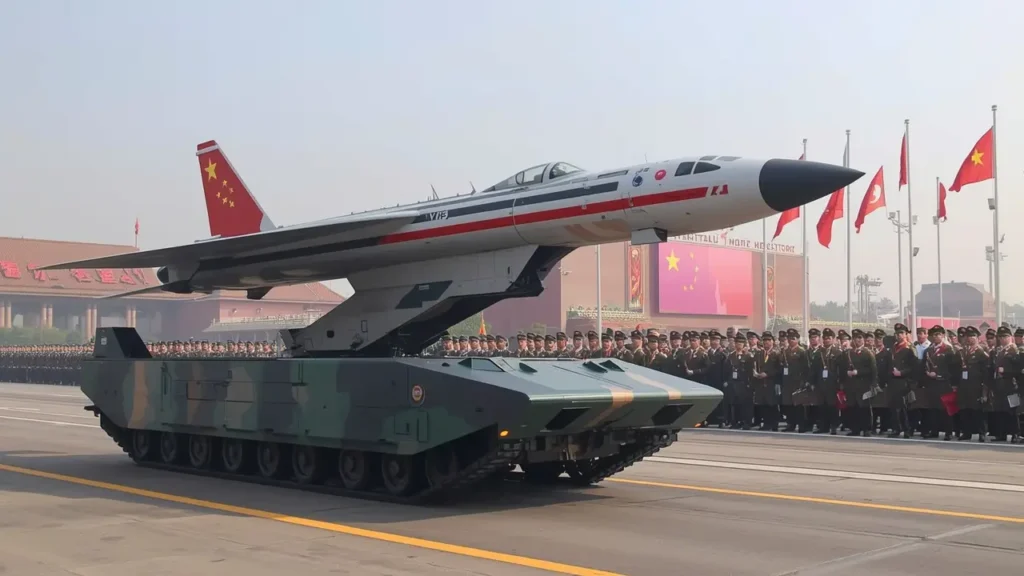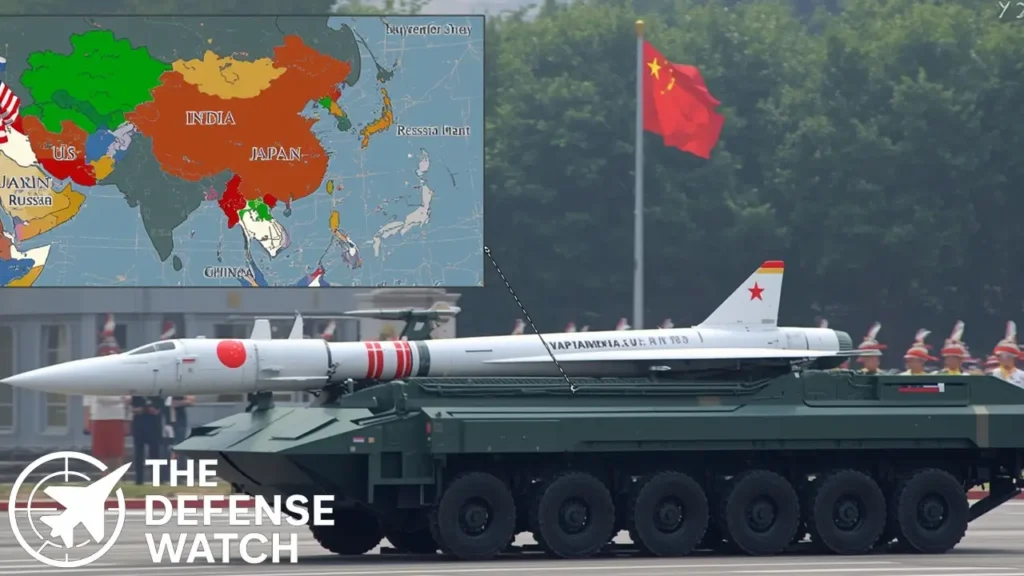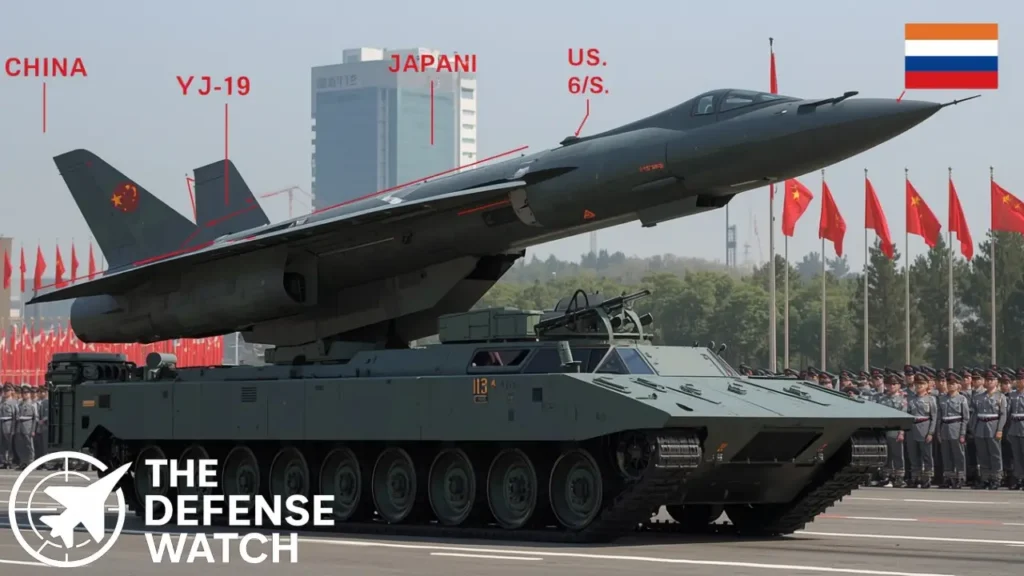Table of Contents
Global Hypersonic Arms Race Accelerates
What’s New?
Hypersonic missile development is surging worldwide. From China’s parade showcasing the latest weapons to India’s major test successes, and Japan’s deployment plans to the U.S. and Russia keeping pace, the strategic balance is shifting rapidly.
China’s Victory Day Parade—Hypersonic Weapon Showcase
During Beijing’s September 3, 2025 Victory Day parade, China unveiled a panoply of hypersonic systems:
- New missiles such as YJ-17, YJ-19, and YJ-20, all designed for anti-ship roles and featuring hypersonic technologies like glide vehicles and scramjet propulsion.
- A full nuclear triad display combining land-, sea-, and air-launched nuclear missiles.
- Analysts warn these systems—especially the hypersonic and drone platforms—could shield key areas from foreign naval presence.

Context:
These additions mark a significant leap in China’s strategic deterrent capabilities, signaling to regional and global actors that it’s closing the technological gap with rivals.
India Breaks Through with Mach-8 Scramjet Missile Trials
India’s DRDO under Project Vishnu achieved a major milestone with the successful trial in July 2025 of the ET-LDHCM—a scramjet-powered hypersonic cruise missile reaching speeds above Mach 8 and a range exceeding 1,500 km.
Significance:
This positions India among a select few nations with operational hypersonic capability, enhancing its regional deterrence and strike flexibility.
Japan to Deploy HVGP and Upgraded Type-12 Missiles by 2027
Japan announced on August 29, 2025, plans to deploy both its upgraded Type-12 surface-to-ship missiles and the Hyper Velocity Gliding Projectile (HVGP)—a hypersonic glide vehicle—across northern, central, and southern bases through 2027.

Takeaway:
Japan is proactively strengthening its counterstrike options amid growing regional threats, leveraging allied support and indigenous development.
U.S. Hypersonic Programs: Momentum and Challenges
Navy & Army: Progress Amid Settingbacks
- The Navy’s Conventional Prompt Strike (CPS) achieved a successful end-to-end test using a cold-gas sea-based launch—the first of its kind—and aims for surface-ship deployment by 2027 and submarine deployment in the early 2030s.
- The Army’s Long-Range Hypersonic Weapon (Dark Eagle), though delayed, is still projected to field this year, with senior officials praising the five-year development pace as “remarkable”.
Air Force Programs Facing Hurdles
- The Air-Launched Rapid Response Weapon (ARRW) is being funded again after prior test issues, with FY2026 budget support confirmed.
- Meanwhile, the Hypersonic Attack Cruise Missile (HACM) project is encountering cost overruns—around $2 billion to date—and schedule delays, though some test cuts may reduce expenses.
Budget Trends and Strategic Assessment
- The Pentagon requested $3.9 billion for hypersonic weapon R&D in FY2026, down from $6.9 billion in FY2025. Simultaneously, hypersonic defense funding rose modestly to $200.6 million.
- Defense tech experts emphasize that these systems are vital for time-sensitive engagement and enabling precision strikes against hardened targets—but also raise questions about cost-effectiveness and strategic stability.

Russia Steps Up with Oreshnik Hypersonic Missile Production
President Vladimir Putin has confirmed mass production of Russia’s Oreshnik intermediate-range hypersonic missile, capable of striking Europe and parts of the U.S. Its long range and speed pose complicating factors for missile defense systems.
Note: Analysts caution its practical value may be limited by high cost and payload constraints, viewing it partly as posturing.
Strategic Assessment
The global push for hypersonic weapons underscores a new era of strategic competition. Nations such as China and India are fast-tracking indigenous systems, while the U.S. is juggling emerging capabilities with testing and budget constraints. Japan hangs closely behind with its glide vehicle rollout, and Russia’s Oreshnik brings renewed complexity.
This trend elevates the imperative for robust hypersonic detection, defense, and arms control frameworks, to avert destabilizing arms races and maintain strategic equilibrium.
FAQs
Hypersonic missiles travel above Mach 5, often combining speed with maneuverability, making them harder to track and intercept compared to conventional systems.
They offer revolutionary deterrence by compressing reaction times, enabling precision strikes against mobile or hardened targets, and potentially overwhelming missile defenses.
High development costs, stringent thermal protection, guidance challenges, and establishing reliable production and defense systems remain key obstacles.
Not yet operationally. As deployment accelerates, experts urge negotiations to include hypersonic weapons in arms control discussions to maintain strategic stability.


10 comments
[…] release reflects a broader shift in U.S. defense strategy. With adversaries fielding maneuverable hypersonic weapons that can bypass existing interceptors, Washington is seeking to leap ahead with a layered system […]
[…] The recent shift comes after discussions at the U.N. General Assembly and alongside renewed calls from Zelenskyy for the U.S. to maintain strong diplomatic and material backing. European Commission President Ursula von der Leyen also affirmed Europe’s intention to intensify sanctions and cut energy dependence on Russia. […]
[…] episode deepens the strategic entanglement between Beijing and Moscow in military technology. If China is willing to cross a threshold (technical support, training, integration) while claiming […]
[…] AI-Armored Cyber Defense: Securing Next-Gen Military Networks Against Evolving Threats Global Hypersonic Arms Race Intensifies: China, India, Japan, Russia & U.S…. Forging Air Dominance: How NATO’s 2025 Joint Air Exercises Reinforce Global… U.S. Army’s […]
[…] Major Step… F-35 Program in 2025: Record Deliveries Expected but Upgrade Delays Cloud… Global Hypersonic Arms Race Intensifies: China, India, Japan, Russia & U.S…. Forging Air Dominance: How NATO’s 2025 Joint Air Exercises Reinforce Global… Columbia-Class […]
[…] That Define Next-Gen… First Flight of Air Force’s YFQ-42A Drone Wingman Marks Major Step… Global Hypersonic Arms Race Intensifies: China, India, Japan, Russia & U.S…. F-35 Program in 2025: Record Deliveries Expected but Upgrade Delays Cloud… Defense Diplomacy: […]
[…] Evolving Strategic Value: Carrier Strike Groups in the Indo-Pacific’s Future Security… Global Hypersonic Arms Race Intensifies: China, India, Japan, Russia & U.S…. Key Features of Boeing’s Sixth-Gen F-47 Fighter Jet That Define Next-Gen… First Flight of […]
[…] Security… Key Features of Boeing’s Sixth-Gen F-47 Fighter Jet That Define Next-Gen… Global Hypersonic Arms Race Intensifies: China, India, Japan, Russia & U.S…. First Flight of Air Force’s YFQ-42A Drone Wingman Marks Major Step… USCYBERCOM FY 2025 […]
[…] Security… Key Features of Boeing’s Sixth-Gen F-47 Fighter Jet That Define Next-Gen… Global Hypersonic Arms Race Intensifies: China, India, Japan, Russia & U.S…. First Flight of Air Force’s YFQ-42A Drone Wingman Marks Major Step… Defense Diplomacy: How […]
[…] Evolving Strategic Value: Carrier Strike Groups in the Indo-Pacific’s Future Security… Global Hypersonic Arms Race Intensifies: China, India, Japan, Russia & U.S…. Key Features of Boeing’s Sixth-Gen F-47 Fighter Jet That Define Next-Gen… Defense […]